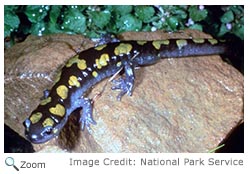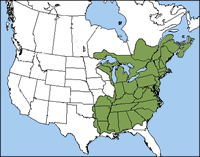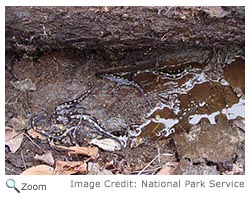Characteristics  The spotted salamander is 6-9 inches in length. Its body is bluish black on top and gray on the bottom. It has two rows of yellow or orange spots starting at its head and running to the tip of its tail. It has 12 costal grooves (vertical grooves). The spotted salamander is also known as the yellow spotted salamander. The spotted salamander is 6-9 inches in length. Its body is bluish black on top and gray on the bottom. It has two rows of yellow or orange spots starting at its head and running to the tip of its tail. It has 12 costal grooves (vertical grooves). The spotted salamander is also known as the yellow spotted salamander.
Range
 The spotted salamander is found from Ontario, Canada east to Nova Scotia, Canada and south to Georgia and Texas. The spotted salamander is found in New Hampshire. The spotted salamander is found from Ontario, Canada east to Nova Scotia, Canada and south to Georgia and Texas. The spotted salamander is found in New Hampshire.
Habitat
The spotted salamander lives in hardwood forests and hillsides.
|
|
Diet
The spotted salamander uses its sticky
tongue to catch worms, insects, and underground snails.
Life Cycle
 The spotted salamander breeds from March to April in the northern part of its range, from January to February in the Great Smokies and from December to February in South. It usually moves to breeding ponds at night during the first rain after the winter thaw. Males arrive at the breeding ponds first. The female lays one or more compact egg masses covered with a jelly-like substance. Each egg mass contains about 100 eggs. The egg masses stick to submerged branches and objects. The larvae hatch in one to two months, depending on the water temperature. Young larvae eat zooplankton and insect larvae and sometimes other spotted salamander larvae. They become salamanders in two to four months. The spotted salamander breeds from March to April in the northern part of its range, from January to February in the Great Smokies and from December to February in South. It usually moves to breeding ponds at night during the first rain after the winter thaw. Males arrive at the breeding ponds first. The female lays one or more compact egg masses covered with a jelly-like substance. Each egg mass contains about 100 eggs. The egg masses stick to submerged branches and objects. The larvae hatch in one to two months, depending on the water temperature. Young larvae eat zooplankton and insect larvae and sometimes other spotted salamander larvae. They become salamanders in two to four months.
Behavior
The spotted salamander is a mole salamander
and spends most of its time underground. It needs areas with soil that is easy to burrow into. Some spotted salamanders can live to be 30 years old!
|